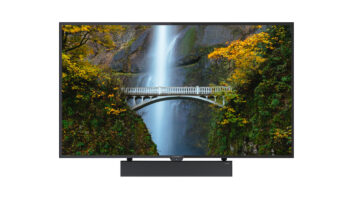Citing forthcoming price cuts and key technology and cosmetic advances in microdisplay rear-projection (MD-RPTV) and flat-panel TVs, leading television manufacturers gave glowing reports of midyear industry performance and forecast more explosive results in the second half of the year.
Although analog television sales predictably are in decline for most screen size segments, manufacturers said sales of digital products have never been stronger, and consumers are almost eagerly spending more money than ever before in stepping up to advanced television technologies.
The leading growth contributors by display type in the first quarter of 2004 were MD-RPTV sets and monitors, and LCD TV, particularly in 30W-inch screen size, which according to a Quixel Research/ Home Theater Research Group (HTRG) study was up 174 percent year-to-date over the first quarter of 2003.
Another big winner through the first quarter of the year is MD-RPTV — including models using DLP, LCD and LCoS technologies. According to Quixel/HTRG research, first quarter U.S. MD-RPTV sales to dealers were 250,928 units, up 528 percent over the first quarter of 2003, and up 64 percent over fourth quarter 2003 numbers. Full year 2003 sales for the category were 328,506 units, according to the study, and that is expected to rise to 1,102,460 units for full year 2004.
“Microdisplay is growing at the rate that we expected, so we are extremely pleased,” said Leo Delaney, Hitachi America’s marketing VP. “PTV [projection television] in general is up over 40 percent over last year in sell-in volume. It’s a good time to be in the business. There is a lot of demand out there, and retailers are responding to it by putting in product.”
Mike O’Hara, Thomson’s executive VP, said, “microdisplay is 15 percent of the industry. And it is a part of the industry that is growing by leaps and bounds. Consumers are looking for value” compared to higher prices currently asked for similarly sized plasma displays.
Hitachi, Thomson and other manufacturers are positioning MD-RPTV products as more affordable alternatives to flat-panel TVs. In some cases, MD-RPTVs sell for roughly half the price of comparably sized plasma displays, today.
Besides price, one of the key benefits of MD-RPTV over plasma panels is unit longevity and screens that are not prone to static image burn-in. Compared to LCD-TVs, MD-RPTVs are typically larger and significantly more affordable in comparable screen sizes.
A key trend in this area is to make cabinet depths slimmer while changing unit styling to closely resemble the look of a plasma panel when seen from most viewing angles. This is winning over women shoppers who are attracted to the clean, contemporary look of the cabinet that takes up much less space in a home.
Thomson, for example, will introduce later this year a line of DLP HDTV sets that measure less than seven inches deep, while Hitachi has introduced a series of LCD-based rear-projection sets that look virtually identical to plasma panels when viewed head-on. Similarly, Samsung has unveiled DLP HDTVs based on a cabinet that looks like a pedestal stand.
According to Quixel/HTRG research, first-quarter U.S. plasma display factory sales were up 66 percent over the year-ago period at 114,924 units, but that was down 11 percent from the fourth quarter of 2003. Quixel/HTRG reported 379,421 unit sales of U.S. plasma panels for full year 2003, and the firm predicts full year 2004 plasma sales rising to 712,346 units.
“Plasma is still doing well, although it’s a little lower than people thought it would be at this time,” said Ed Wolff, Panasonic’s display group merchandising VP. “I think that is due to a combination of the price points at the time, the uncertainty of the economy, and the seasonality of the category that we are beginning to realize.”
Bob Perry, LG Electronics’ sales VP, picked plasma as a major producer for the second half of 2004, adding that sales of plasma displays, spurred by aggressive price moves from brands with core manufacturing capability, could impact sales of MD-RPTV products.
“New price points, integration with digital tuners and digital cable-ready CableCARD capability are key factors in the maturity of this product segment,” Perry said. “We expect plasma to strongly impact other competitive technologies. As pricing and feature sets become more comparable, we believe that the consumer will always choose flat and cool.”
Jonas Tanenbaum, Samsung’s flat-panel products senior marketing manager, said that “depending on who you speak to, projections for LCD and plasma are both going to basically double for this year. The question I ask is, ‘How is that going to happen?’ Are consumers going to suddenly wake up one day and say, ‘I need to have a flat-panel TV?’
“I think we will see some new brands in the marketplace. We will see products delivering higher performance than ever before and pricing is coming down. But it hasn’t really eroded year-to-date to any significant degree,” he continued. “So we are probably set up to see more rapid price declines in the second half, particularly in plasma.”
Advantages of plasma displays are their thin form-factor, wide viewing angle and good image quality.
LCD TV has astounded most industry observers with its strong performance in the first quarter. According to Quixel/ HTRG, U.S. factory unit sales of LCD TVs topped 792,000 in 2003, and had already hit 265,814 units in the first quarter of 2004. The research firm projects full year 2004 LCD TV unit sales climbing to 1,705,071.
The 30-inch and larger segment tallied unit sales of 22,627, which Quixel/ HTRG said is “already more than half of the 2003 total” of 43,461 units.
Sharp Electronics’ display devices product marketing director Bruce Tripido projected full-year LCD TV industry sales “of somewhere between 1.8 and 2 million units. Last year it was about 800,000 to 850,000. A number of factors are driving demand, including many more options for the consumer — there are more screen sizes, and more product iterations.
“With the different types of products and screen sizes also comes the entrance of a number of competitors into the marketplace,” Tripido continued. “The end result is pricing compresses a bit; products become a bit more affordable for the end user; and the industry becomes very hot, very quickly, which is what we are seeing right now.”
“Consumers look at flat screen and think that is what it is all about,” said Greg Godorf, Sony Electronics Home Products VP. “The entire industry, from manufacturers, retailers to the guys on the selling floor must explain the differences between ED flat screens and true HD. We need a full education message, a clear message to the consumer to focus on value.”
Des Power, Philips Consumer Electronics’ senior VP said “We are preparing, absolutely, for the consumer value proposition in flat-panel TV — as we go into the back half of this year — becoming extremely enticing.”
Many in the industry believe that if large panel LCD TV pricing can be brought down to meet or beat plasma, it will stand as the format of choice in the future. LCD TVs offer strong color saturation, thin cabinet form-factor, long life span without threat of static image burn-in, and a continually improving contrast performance.













